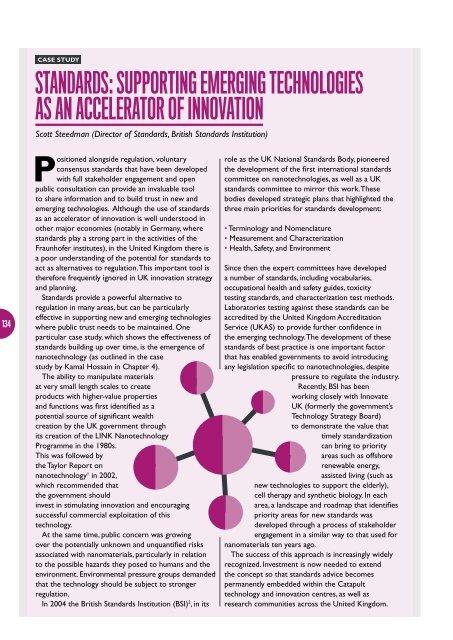14-1190b-innovation-managing-risk-evidence
14-1190b-innovation-managing-risk-evidence
14-1190b-innovation-managing-risk-evidence
Create successful ePaper yourself
Turn your PDF publications into a flip-book with our unique Google optimized e-Paper software.
CASE STUDY<br />
STANDARDS: SUPPORTING EMERGING TECHNOLOGIES<br />
AS AN ACCELERATOR OF INNOVATION<br />
Scott Steedman (Director of Standards, British Standards Institution)<br />
134<br />
Positioned alongside regulation, voluntary<br />
consensus standards that have been developed<br />
with full stakeholder engagement and open<br />
public consultation can provide an invaluable tool<br />
to share information and to build trust in new and<br />
emerging technologies. Although the use of standards<br />
as an accelerator of <strong>innovation</strong> is well understood in<br />
other major economies (notably in Germany, where<br />
standards play a strong part in the activities of the<br />
Fraunhofer institutes), in the United Kingdom there is<br />
a poor understanding of the potential for standards to<br />
act as alternatives to regulation. This important tool is<br />
therefore frequently ignored in UK <strong>innovation</strong> strategy<br />
and planning.<br />
Standards provide a powerful alternative to<br />
regulation in many areas, but can be particularly<br />
effective in supporting new and emerging technologies<br />
where public trust needs to be maintained. One<br />
particular case study, which shows the effectiveness of<br />
standards building up over time, is the emergence of<br />
nanotechnology (as outlined in the case<br />
study by Kamal Hossain in Chapter 4).<br />
The ability to manipulate materials<br />
at very small length scales to create<br />
products with higher-value properties<br />
and functions was first identified as a<br />
potential source of significant wealth<br />
creation by the UK government through<br />
its creation of the LINK Nanotechnology<br />
Programme in the 1980s.<br />
This was followed by<br />
the Taylor Report on<br />
nanotechnology 1 in 2002,<br />
which recommended that<br />
the government should<br />
invest in stimulating <strong>innovation</strong> and encouraging<br />
successful commercial exploitation of this<br />
technology.<br />
At the same time, public concern was growing<br />
over the potentially unknown and unquantified <strong>risk</strong>s<br />
associated with nanomaterials, particularly in relation<br />
to the possible hazards they posed to humans and the<br />
environment. Environmental pressure groups demanded<br />
that the technology should be subject to stronger<br />
regulation.<br />
In 2004 the British Standards Institution (BSI) 2 , in its<br />
role as the UK National Standards Body, pioneered<br />
the development of the first international standards<br />
committee on nanotechnologies, as well as a UK<br />
standards committee to mirror this work. These<br />
bodies developed strategic plans that highlighted the<br />
three main priorities for standards development:<br />
• Terminology and Nomenclature<br />
• Measurement and Characterization<br />
• Health, Safety, and Environment<br />
Since then the expert committees have developed<br />
a number of standards, including vocabularies,<br />
occupational health and safety guides, toxicity<br />
testing standards, and characterization test methods.<br />
Laboratories testing against these standards can be<br />
accredited by the United Kingdom Accreditation<br />
Service (UKAS) to provide further confidence in<br />
the emerging technology. The development of these<br />
standards of best practice is one important factor<br />
that has enabled governments to avoid introducing<br />
any legislation specific to nanotechnologies, despite<br />
pressure to regulate the industry.<br />
Recently, BSI has been<br />
working closely with Innovate<br />
UK (formerly the government’s<br />
Technology Strategy Board)<br />
to demonstrate the value that<br />
timely standardization<br />
can bring to priority<br />
areas such as offshore<br />
renewable energy,<br />
assisted living (such as<br />
new technologies to support the elderly),<br />
cell therapy and synthetic biology. In each<br />
area, a landscape and roadmap that identifies<br />
priority areas for new standards was<br />
developed through a process of stakeholder<br />
engagement in a similar way to that used for<br />
nanomaterials ten years ago.<br />
The success of this approach is increasingly widely<br />
recognized. Investment is now needed to extend<br />
the concept so that standards advice becomes<br />
permanently embedded within the Catapult<br />
technology and <strong>innovation</strong> centres, as well as<br />
research communities across the United Kingdom.


